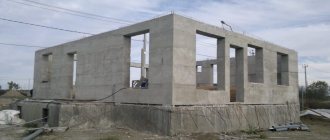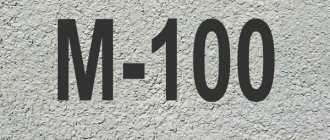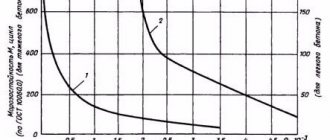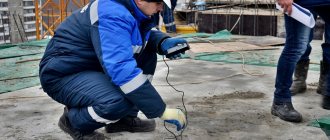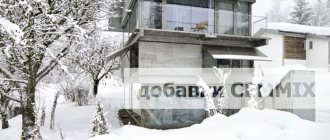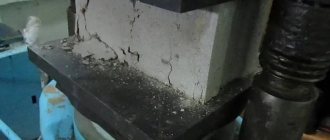Every year, millions of cubic meters of concrete and reinforced concrete waste are generated around the world.
And the annual increase in scrap expected in Russia alone from the accumulation of defective structures and from the dismantling of old buildings is equivalent to 15-17 million tons.
Most of this type of construction waste is disposed of in landfills, including unauthorized ones, located in urban areas.
Such actions negatively affect the environmental situation, so large cities need to use technologies for recycling concrete residues.
The economic justification for recycling scrap is to reduce the cost of products from waste and free up space.
Definition
The category includes residues generated during the production of commercial products by enterprises in the construction industry - concrete and reinforced concrete:
- defects from the production of products with cracks, chips;
- technological waste;
- concrete dust;
- dried and liquid solutions.
Concrete and reinforced concrete residues (RCR) are also generated in the construction industry, including :
- New construction;
- reconstruction and repair of facilities;
- demolition and dismantling of outdated, dilapidated, emergency buildings and structures.
Construction concrete waste consists of pieces of different sizes and shapes, scrap, and broken products.
These include fragments :
- structures of obsolete buildings;
- road slabs;
- piles;
- supports
The category also includes concrete waste and concrete waste from the reclamation of industrial and natural landfills.
Areas of application
Despite all its advantages, crushed concrete is inferior to natural crushed stone in strength, water resistance, abrasion and other parameters. For this reason, it is not used in the construction of critical structures, but other uses are found for it. Most often, these are structures whose appearance and quality are not subject to increased requirements.
This:
- Temporary and minor roads with light traffic, bypass routes;
Road surface
- Road embankments;
Railway embankment
- Construction sites, parking lots, industrial yards;
Parking
- Garden paths and playgrounds;
Photo of the original garden path
- Filling of swamps and other natural reservoirs, ravines, holes, trenches and pits;
Filling the ravine
- Strengthening wetlands, banks and slopes;
The shore of the pond, fortified with gabions with concrete battlements
- Creation of drainage systems in wetlands;
Foundation drainage
- Creation of a filter layer in wells and artificial reservoirs;
Filling the bottom of the filter well
- Production of concrete solutions for pouring foundations, blind areas, floors and other concrete structures, including small architectural forms;
Preparation of the solution
- Application in landscape design.
Wall made of gabions filled with large fragments of concrete
Broken red brick has a similar scope of application, so recycled crushed stone is often mixed and contains both materials. But the strength of brick to static loads is lower, and water absorption is higher, so in each case you should decide whether to purchase a “pure” or a mixed composition. But broken brick is an excellent sound and heat insulator, which builders often use. They fill the internal cavities of walls and insulate underground pipelines.
Insulation of the drain pipe
FCKO
According to the Federal Classification Catalog of Waste (FKKO), the remains of concrete and reinforced concrete belong to the blocks:
- block 3 “Waste from processing industries” (FKKO code 30000000000);
- block 4 “Consumer waste, materials and products that have lost their consumer properties” (FKKO code 40000000000);
- block 8 “Construction and repair waste” (code 80000000000).
Classification of waste related to block 3:
| Type | Waste | Subtypes | Waste | Groups, subgroups | Waste |
| 34000000000 | Production of other non-metallic mineral products | 34600000000 | Production of concrete, concrete products | 34610000000 34611000000 34612000000 | Production of ready-mixed concrete, dry concrete mixtures |
| 34620000000 | Production of concrete products for use in construction |
Classification of waste concrete and reinforced concrete that has lost its consumer properties (block 4 of the FKKO):
| Type | Waste | View | Waste |
| 45000000000 | Other non-metallic mineral products | 45841111525 | Concrete targets in a cardboard shell |
Block 8 includes the following waste related to construction and repairs:
| Type | Waste | Subtypes | Waste |
| 81000000000 | Preparation of the construction site, dismantling and demolition of buildings | 81900000000 | Others |
| 82000000000 | Construction of buildings and structures | 82200000000 | Based on concrete, cement, mortars |
| 82900000000 | Others |
The essence of recycling technology
The most common method of recycling is sifting crushed reinforced concrete fragments through a sieve.
Processing of concrete products through this device includes the following steps:
- Inspection of material intended for disposal and distribution of elements.
- Destruction of large concrete blocks. Special hydraulic shears are used for crushing.
- Loading crushed fragments into the hopper and launching the crushing complex.
- Passing through a sieve. The device creates vibration. This effect on the material eliminates secondary crushed stone. Only elements made of metal remain on the sieve.
- Sorting the received material.
A more modern method of processing reinforced concrete is the use of magnetic crushing complexes. Such equipment works more efficiently because the magnet attracts metal fragments without retaining concrete ones.
Hazard classes
In accordance with the FKKKO classifier, concrete and reinforced concrete waste belongs to the following hazard classes.
Waste from processing industries (block 3):
| Waste category | FKKO codes | Name of waste | Hazard Class |
| Production of concrete and concrete products | 34611214214 | Hardened lime mortar, lump form | 4 |
| 34611511214 | Production of ready-mixed concrete:
| 4 | |
| 34611513215 |
| 5 | |
| 34611713394 34611714394 34611715394 |
| 4 | |
| 34611811214 34611812215 |
| 4 5 | |
| 34612001424 | Concrete mixture in the form of dust | 4 | |
| 34612111495 | Sand screening | 5 | |
| 34620001205 34620002205 | Production of products for use in construction:
| 5 | |
| 34620003424 |
| 4 | |
| 34621111394 34621112204 |
| 4 |
Construction and repair waste (block  :
:
| Waste category | FKKO codes | Name of waste | Hazard Class |
| Dismantling and demolition of buildings | 81991111704 | A mixture of solid products and materials, predominantly containing concrete | 4 |
| Construction of structures and buildings | 82202112495 | Loose dry concrete mixture | 5 |
| 82220101215 82230101215 | Pieces of waste concrete, reinforced concrete and scrap products | 5 | |
| 82221111204 | Solid concrete scrap for construction and repair of industrial buildings | 4 | |
| 82223111204 82233111204 | Solid waste of concrete and reinforced concrete contaminated with petroleum products | 4 | |
| 82291111204 | A mixture of solid scrap concrete and reinforced concrete for dismantling building structures | 4 | |
| 82913111205 | Wooden formwork contaminated with concrete | 5 | |
| 82915111624 | Duplicated textile fiber materials for construction contaminated with concrete | 4 |
From the above sample it is clear that concrete and reinforced concrete waste have hazard classes:
- 4 - low-hazard waste, with a low level of harmful impact on the environment;
- 5 – practically non-hazardous, with very low environmental impact.
Construction waste of hazard class 4, except for coarse and large-sized objects, is taken to landfills, which worsens the environmental situation .
At the same time, scrap concrete is a valuable secondary raw material, the processing of which into crushed stone allows reducing investments in the construction of new facilities, at the same time reducing the load on city landfills and eliminating the movement of construction waste to unauthorized landfills.
Harm to the environment
Remains of reinforcement are classified as hazard class IV, and waste concrete is classified as hazard class 5. They do not cause much harm to the environment, but as garbage in landfills they take up too much space and slowly deteriorate (up to 100 years). High-quality steel enclosed in a stone shell does not rust for a long time.
In Russia, tons of waste concrete products are still transported to landfills. However, in the near future the situation should change, as more and more enterprises appear that produce equipment for recycling concrete or are engaged in waste processing.
Recycling waste concrete and reinforced concrete
Recycling construction waste is profitable and economical. Often, when old buildings are demolished, a new building is erected in the same place, requiring a large amount of crushed stone. The material can be obtained from scrap concrete. Preparing concrete using recycled crushed stone reduces its cost by 25%.
Several ways of processing concrete and reinforced concrete residues are used in the world:
- After the structures are dismantled, the waste is transported to a facility to produce a secondary product, which is then sent to a concrete plant.
- Recycling of concrete waste is carried out at the site of dismantling work using installed equipment. The resulting product is sent to a construction site or concrete production plant.
- Recycling of scrap concrete and the production of new products based on it is organized directly at the site of dismantling work.
In domestic processing practice, the second or third options are predominantly used.
Concrete recycling
Technological equipment for processing substandard concrete includes the following types of installations :
- destruction or primary crushing;
- secondary crushing;
- fractionation.
Crushing of concrete waste is carried out using stationary or mobile (self-propelled) installations. Operation on stationary devices has a simple operating principle.
Waste enters the receiving bin and is sorted. Then they are crushed in a crusher. Next, the concrete mass is divided into fractions on a screen - crushed stone and sand . Large debris that is not sorted is returned to the crusher.
The main disadvantages of stationary crushers are their high price and bulkiness, which does not allow the installation to be transported outside the processing plant.
If it is impossible or ineffective to use stationary crushing and screening complexes, mobile type installations are used . The waste recycling process is similar to stationary devices.
Recycling of reinforced concrete
Reinforced concrete waste (RCW) contains concrete and metal reinforcement, which must be separated from each other .
Therefore, the design parameters of technological equipment for processing reinforced waste must be selected taking into account the presence of reinforcement in the scrap and the impossibility of maintaining the exact dimensions of the supplied material, as well as controlling the shape of the fragment.
Due to this fact, some units of crushing mechanisms for processing reinforced concrete are much larger than similar units of installations for crushing concrete scrap that have the same productivity.
When destroying reinforced concrete materials, methods are used:
- mechanical (splitting, impact destruction, crushing, cutting);
- non-mechanical (destruction - electric pulse, electrohydraulic, explosive; cutting - thermal, water jet).
The most expedient method of destruction, both from a technological and economic point of view, is the mechanical method.
In world practice, the most popular types of crushers for reinforced concrete waste are rotary and jaw crushers. The impact rotor installation, designed for primary crushing of reinforced waste materials, due to the design features of the feed, is capable of crushing material of only limited sizes. Therefore, the extended reinforcement will not fit around the rotor of such a crusher.
significantly from impact crushers . There are no obstacles that impede the passage of reinforcement. The destruction of reinforced concrete is efficient. For example, to dismember scrap of dense reinforced concrete (piles, sleepers, pillars, slabs), vibrating jaw-type crushing units are used.
The reinforcement is destroyed along the welded seams, being well cleaned from the concrete. The metal is sent for remelting, and the concrete part, consisting of crushed stone and cement stone, is sent for the production of crushed stone or crushing of the stone to cement coarseness.
Reinforcement products removed from concrete are removed using:
- magnetic drums;
- stationary magnets;
- magnetic above-conveyor separators.
After the initial crushing of reinforced concrete, large parts of reinforcement are removed from the upper layer using a magnetic separator, and small debris from the lower layer of material is collected with a magnetic drum.
Why do you need to recycle reinforced concrete waste?
Recycling is the processing of concrete waste with the possibility of its reuse. To organize it you will have to incur certain costs, but they pay off due to:
- Disposal of all accumulated waste in previous years.
- Elimination of significant costs for transporting waste to landfills, which may be quite far away.
- Increasing the performance of concrete mixing equipment due to timely and complete cleaning of the walls.
- Exceptions to fines for environmental violations.
In addition, the recycled material obtained after processing can be used by ourselves or sold to other organizations and individuals. Recycled raw materials help reduce the profitability of new concrete mortar by using it as a filler.
Formed products and their application
After crushing concrete scrap, secondary crushed stone is formed - a loose mixture of granular material of different fractions and different shapes.
On the screen of the crushing and screening plant, the pieces are divided into 2 main fractions with sizes: 40-150 mm and 0-40 mm. The strength characteristics of crushed stone depend on the source material being crushed.
Recycled crushed stone is used for manufacturing:
- Concrete mixtures for the production of concrete blocks for basement walls.
- Concrete wall stones.
- Foundation slabs.
- Bases for road surfaces, platforms.
- Underlayment layers during the construction of sidewalks.
Crushed stone is also used in landscape architecture or as backfill to replace missing soil during construction work.
The fine fraction in the form of screenings up to 5 mm in size is used as an active organomineral additive . Pulverized filler is used as a filler in the manufacture of mortar.
Crushed waste of cellular concrete is used as fillers in mortars, fertilizers, and added to feed in poultry farms.
Finnish technology involves the use of water and aggregate washed from waste to produce new concrete. And finely dispersed sludge containing a large amount of calcium oxide is used in the agricultural industry for liming soils.
Necessary equipment
At the first stage of processing, it is necessary to ensure coarse grinding of concrete structures. For this purpose, fairly powerful coarse crushing screens are used. Among domestic equipment, we can highlight the SMD-133A unit. Among the imported equipment, the following screens stand out: Turbo Screen EXTEC and PowerScreen. McCloskey International offers a wide range.
The next step is to crush large pieces of concrete. Crushers, sorting units, and vibrating screens are used. The following effective equipment is noted: domestic SMD-174A units, imported crushers - Metso, Parker Plant, Pegson. Conveyors (SMD-151, SMD-152) are used to supply raw materials and fractions.
When processing waste concrete products, at the first stage it is necessary to separate the metal elements of the reinforcement. For this purpose, crushing plants and screens are equipped with powerful magnetic separators.
For deep processing of concrete waste, special recycling lines are used. When recycling directly on a construction site, mobile units are most suitable. They contain the following components:
- Cyclonic separation system. A stream of running water is supplied here using a 5-7.5 kW pump.
- Screw-type auger with a gear motor with a power of 5-7 kW. Usually removable blades are installed, because they rub against solid particles quite actively.
- Slurry basin with a volume of 40-80 cubic meters. It is equipped with a stirrer (mixer) with a power of 3-5 kW. Pumps with a power of 2-3 kW are used to supply clean water to the pool and pump out waste water.
- Water regeneration. Taking into account its high consumption, systems for cleaning (regeneration) and returning it back to work are installed. The quality of water purification and drainage frequency are controlled and regulated electronically.
- Filtration system for separating sand from cement laitance. A special filter allows you to eliminate unwanted impurities (garbage).
- Press filter for maximum dehydration of the finished secondary product.
- Vibrating sieve for separating crushed stone into fractions and screening out solid impurities.
When cleaning concrete mixers and simultaneously processing accumulated concrete waste, the line is equipped with a device that ensures that the solution is washed off from the walls under the pressure of a water jet. The resulting mixture is sent to the separation system.
Recycling lines are produced by many construction equipment companies. Among domestic manufacturers, one can highlight Stroytekhnika PA. BIBKO equipment proved to be effective. The full cycle of disposal and recycling of construction waste is provided by the large company SATORI.


